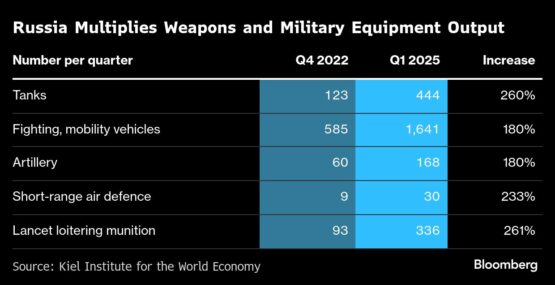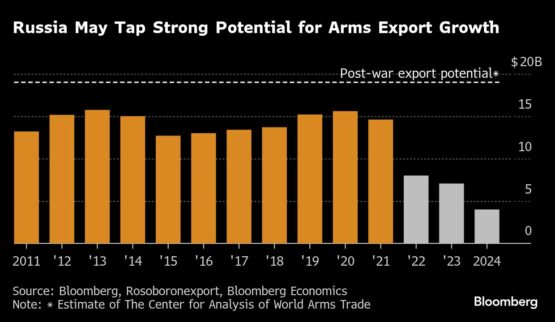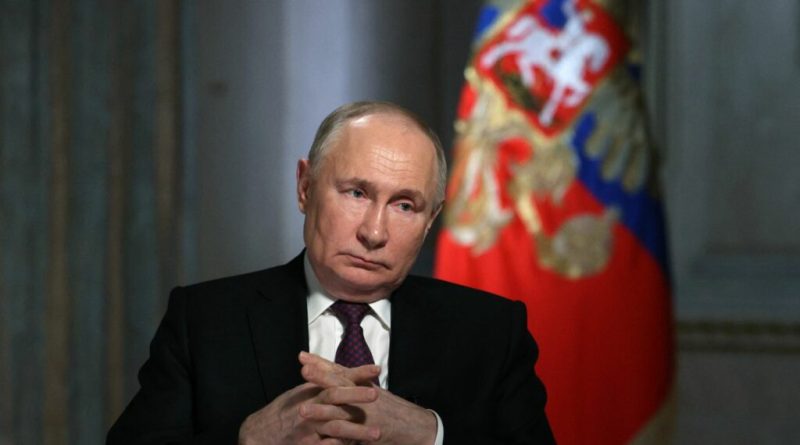Putin’s War Machine Now Seamlessly Integrated into the Russian Economy
Even if the conflict in Ukraine comes to an end, Russia’s economy may continue to be rooted in militarization.
Years of substantial defense expenditure have entrenched the country in a military-oriented conversion of its manufacturing sector, engaging hundreds of thousands of workers. This surge has mitigated economic downturn, making any withdrawal from this path more complex.
The Kremlin remains steadfast in its approach. President Vladimir Putin sees a continuous necessity for a strong Russian military — a concept that Western leaders fear could be aimed at NATO within five years — and intends to incorporate the thriving defense industry into his long-term agenda.
As he presents his initiatives and Europe injects billions to enhance its military capabilities, the critical question arises: what will happen to the excess tanks and missiles produced by Russian manufacturers?
Moscow could transform what is currently a financial strain into a lucrative opportunity by exporting arms to allies like China. However, as these weapons stockpile along NATO’s eastern front, they pose a risk of destabilizing relations with Europe, compounding issues for an economy already burdened by sanctions, a failing banking system, and slow growth.
During a recent tour of Russia’s oldest defense manufacturing plant, Putin suggested planning beyond the war’s conclusion, remarking that “the need for modern armed forces won’t end there.”
The acceleration of military production in Russia is noteworthy. Before its large-scale invasion of Ukraine in 2022, the goal was to manufacture approximately 400 armored vehicles the subsequent year; it is now producing ten times that amount.

Additionally, innovations have emerged, with Russia establishing its own drone production lines after these became crucial in the conflict. Initially relying on Iranian imports, it produced 1.5 million drones last year, a steep increase from 140,000 in 2023.
ADVERTISEMENT
CONTINUE READING BELOW
The financial impact of the war has been substantial. Defense spending from 2022 to 2024 has exceeded 22 trillion rubles ($263 billion) according to available official data. With no indication of reduction over the next three years, budget deficits are anticipated to worsen, already heightened by sanctions.
Insights from the post-World War II era could provide guidance on how Russia might leverage its expanded military industrial base: The Soviet Union’s pivot to a war economy in 1941 set the stage for becoming a leading arms supplier once fighting ended, as noted by Tatiana Orlova of Oxford Economics.
“The Russia-Ukraine conflict has become a broad testing ground for new weaponry and technologies,” she mentioned. Once hostilities cease or stall, “both nations are likely to market the technologies and equipment that have shown the most success.”
What Bloomberg Economics says…
“It’s improbable that Russia will halt the militarization of its economy, even if the situation in Ukraine resolves. The ongoing geopolitical tensions between Moscow and the West are not expected to diminish. This persistent rivalry will likely sustain much of the Russian defense sector at production levels significantly higher than pre-2022 levels, in preparation for possible future military conflicts,” asserted Alex Kokcharov, a geoeconomics analyst.
Before the invasion of Ukraine, Russia was already the world’s second-largest arms supplier, following the US. While its sales dwindled in recent years due to prioritizing the war effort, there are indications of a possible revival.
The defense industry is re-engaging in arms trade fairs across India, China, the Middle East, and Africa. For the first time in six years, Russian weaponry was showcased at exhibitions in Malaysia and Brazil, featuring an extensive array of military hardware. Opportunities for technology exchanges and collaborative production also exist.
State arms exporter Rosoboronexport, overseeing about 85% of international sales, reports a backlog of orders amounting to a record $60 billion, guaranteeing demand for factories and multi-year contracts.
Russia could potentially export between $17 billion and $19 billion worth of military equipment annually within the first four years after the conflict in Ukraine, as projected by the Centre for Analysis of World Arms Trade, highlighting demand in the global south where countries aim to reduce dependence on the US.
ADVERTISEMENT:
CONTINUE READING BELOW

“The demand for Russian military technology remains strong,” noted Anna Borshchevskaya, a senior fellow at the Washington Institute for Near East Policy. “Officials from the Middle East and North Africa are likely to view any temporary peace in Ukraine as an opportunity to take advantage of Moscow’s updated supply capabilities.”
A key attractive factor is pricing, as the increased output has generated significant economies of scale, making some products more economical compared to pre-invasion costs.
This strategy does come with hurdles. While Rosoboronexport’s backlog provides a considerable buffer, should government budgets be tightened, it still constitutes less than half of the annual defense spending. Furthermore, certain potential purchasers may face pressure from Western nations, reminiscent of previous instances where leaders like Donald Trump urged India to stop purchasing Russian oil.
Although military production facilities continue their operations — providing employment and supporting economic growth — layoffs and salary reductions are plausible, according to Orlova from Oxford Economics. She noted that exports alone may not support the high operational levels currently seen.
Putin claims that funds directed toward military manufacturing have been wisely invested, acknowledging the challenges ahead. To ease the forthcoming transition, he advocates not only for increased arms exports but also enhanced synergy between military and civilian industries.
He envisions dual-use production as viable for components within sectors such as shipbuilding, aviation, electronics, medical supplies, and agriculture.
Nonetheless, the primary concern for Putin as he makes decisions is maintaining a combat-ready military that can be relied upon beyond ongoing operations, indicating that Russia’s expanded production capacity is here to stay.
© 2025 Bloomberg
Follow Moneyweb’s comprehensive finance and business news on WhatsApp here.

